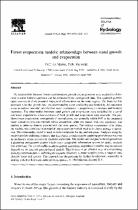JavaScript is disabled for your browser. Some features of this site may not work without it.
- ResearchSpace
- →
- Research Publications/Outputs
- →
- Journal Articles
- →
- View Item
| dc.contributor.author |
Le Maitre, David C

|
en_US |
| dc.contributor.author |
Versfeld, DB

|
en_US |
| dc.date.accessioned | 2007-02-08T07:08:00Z | en_US |
| dc.date.accessioned | 2007-06-07T10:03:56Z | |
| dc.date.available | 2007-02-08T07:08:00Z | en_US |
| dc.date.available | 2007-06-07T10:03:56Z | |
| dc.date.issued | 1997-06 | en_US |
| dc.identifier.citation | Le Maitre, DC, Versfeld, DB. 1997. Forest evaporation models: Relationships between stand growth and evaporation. Journal of Hydrology, vol 193, 04 January, pp 240-257 | en_US |
| dc.identifier.issn | 0022-1694 | en_US |
| dc.identifier.uri | http://hdl.handle.net/10204/1632 | en_US |
| dc.identifier.uri | http://hdl.handle.net/10204/1632 | |
| dc.description.abstract | The relationships between forest stand structure, growth and evaporation were analysed to determine whether forest evaporation can be estimated from stand growth data. This approach permits rapid assessment of the potential impacts of afforestation on the water regime. The basis for this approach is (a) that growth rates are determined by water availability and limited by the maximum water extraction potential, and (b) that stand evaporation is proportional to biomass and biomass increment. The relationships between stand growth and evaporation were modelled for a set of catchments experiments where estimates of both growth and evaporation were available. The predicted mean evaporation, over periods of several years, was generally within 10% of the measured mean annual evaporation (rainfall minus stream flow) when the model from one catchment was applied to other catchments planted with the same species. The residual evaporation, after fitting the models, was correlated with rainfall: above-average rainfall resulted in above-average evaporation. This relationship could be used to derive estimates for dry and wet years. Analyses using the models provide additional evidence that Eucalyptus grandis may be depleting groundwater reserves in catchments where its roots can reach the water table. The models are designed to be integrated into a plantation management system which uses a geographic information system for spatial analysis and modelling. The use of readily available growth parameters as predictor variables may reduce our dependence on intricate process-based models. This is seen as an efficient way of extrapolating existing catchment data - reflecting the impacts of forestry on water supplies across a range of sites, climatic zones and species. This approach has the potential for further development, especially in dealing with low flows and faster growing species. | en_US |
| dc.format.extent | 810349 bytes | en_US |
| dc.format.mimetype | application/pdf | en_US |
| dc.language.iso | en | en_US |
| dc.publisher | Elsevier Science BV | en_US |
| dc.rights | Copyright: 1997 Elsevier Science B.V. | en_US |
| dc.subject | Forest evaporation | en_US |
| dc.subject | Afforestation | en_US |
| dc.subject | Eucalyptus grandis | en_US |
| dc.subject | Catchments | en_US |
| dc.subject | Water resources | en_US |
| dc.title | Forest evaporation models: Relationships between stand growth and evaporation | en_US |
| dc.type | Article | en_US |
| dc.identifier.apacitation | Le Maitre, D. C., & Versfeld, D. (1997). Forest evaporation models: Relationships between stand growth and evaporation. http://hdl.handle.net/10204/1632 | en_ZA |
| dc.identifier.chicagocitation | Le Maitre, David C, and DB Versfeld "Forest evaporation models: Relationships between stand growth and evaporation." (1997) http://hdl.handle.net/10204/1632 | en_ZA |
| dc.identifier.vancouvercitation | Le Maitre DC, Versfeld D. Forest evaporation models: Relationships between stand growth and evaporation. 1997; http://hdl.handle.net/10204/1632. | en_ZA |
| dc.identifier.ris | TY - Article AU - Le Maitre, David C AU - Versfeld, DB AB - The relationships between forest stand structure, growth and evaporation were analysed to determine whether forest evaporation can be estimated from stand growth data. This approach permits rapid assessment of the potential impacts of afforestation on the water regime. The basis for this approach is (a) that growth rates are determined by water availability and limited by the maximum water extraction potential, and (b) that stand evaporation is proportional to biomass and biomass increment. The relationships between stand growth and evaporation were modelled for a set of catchments experiments where estimates of both growth and evaporation were available. The predicted mean evaporation, over periods of several years, was generally within 10% of the measured mean annual evaporation (rainfall minus stream flow) when the model from one catchment was applied to other catchments planted with the same species. The residual evaporation, after fitting the models, was correlated with rainfall: above-average rainfall resulted in above-average evaporation. This relationship could be used to derive estimates for dry and wet years. Analyses using the models provide additional evidence that Eucalyptus grandis may be depleting groundwater reserves in catchments where its roots can reach the water table. The models are designed to be integrated into a plantation management system which uses a geographic information system for spatial analysis and modelling. The use of readily available growth parameters as predictor variables may reduce our dependence on intricate process-based models. This is seen as an efficient way of extrapolating existing catchment data - reflecting the impacts of forestry on water supplies across a range of sites, climatic zones and species. This approach has the potential for further development, especially in dealing with low flows and faster growing species. DA - 1997-06 DB - ResearchSpace DP - CSIR KW - Forest evaporation KW - Afforestation KW - Eucalyptus grandis KW - Catchments KW - Water resources LK - https://researchspace.csir.co.za PY - 1997 SM - 0022-1694 T1 - Forest evaporation models: Relationships between stand growth and evaporation TI - Forest evaporation models: Relationships between stand growth and evaporation UR - http://hdl.handle.net/10204/1632 ER - | en_ZA |






